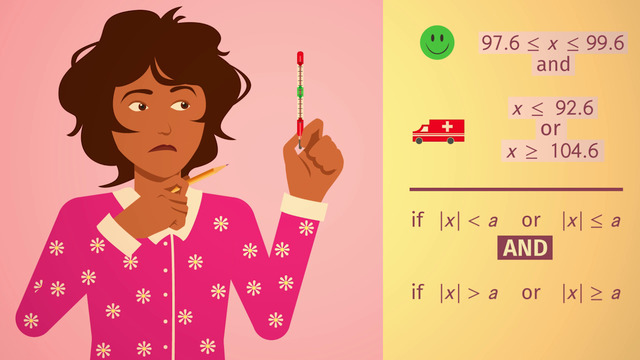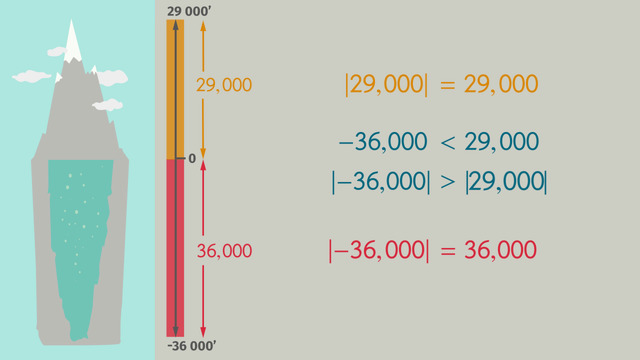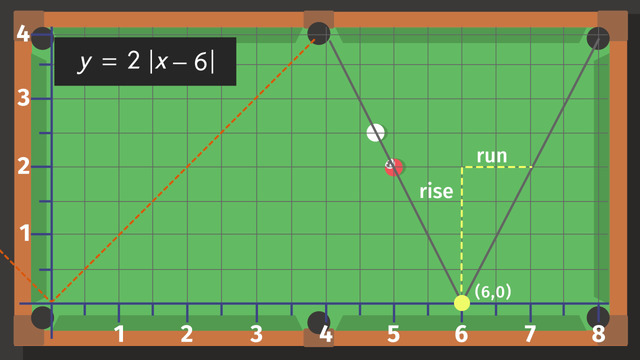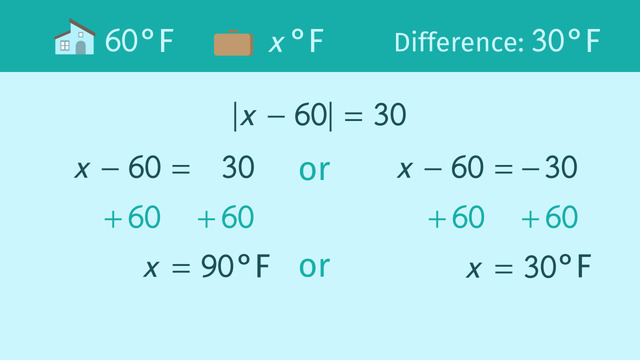Absolute Value Inequalities


Basics on the topic Absolute Value Inequalities
Absolute value inequalities can include variable expressions inside the absolute value bars. How do you solve for a variable that’s between the bars?
Similar to absolute value equations with a variable expression inside the absolute value bars, you must set up a positive and negative situation, but look out because inequalities behave differently depending if they are less than or greater than situations (also less than and equal to or greater than and equal to).
For less than situations, an AND situation is created. To reflect |x| < v, set up a positive and negative inequality: –v < x AND x < v. Solve for both, and graph the two solutions on a number line; the solution to the absolute value inequality is the intersection of the two solutions. You will notice the graph has a distinctive appearance, as only one section of the graph is shaded.
For greater than situations, an OR situation is created. To reflect |x| > v, set up a positive and negative inequality: x < -v OR x > v. Solve for both, and graph the two solutions on a number line; the solution to the absolute value inequality is the union of the two solutions. Just like before, the graph has a distinctive appearance, but this time it’s shaded in two separate sections.
When inequalities contain AND and OR solutions they are also called compound inequalities. Often, students find this topic challenging, but if you watch out for the pattern of AND and OR situations, you’ll be okay but just in case, watch this video to discover the cure for absolute value inequality headaches.
Represent and solve equations with absolute value.
CCSS.MATH.CONTENT.HSA.REI.D.11
Transcript Absolute Value Inequalities
Daisy plans to go to the Super Bowl parade, so she wants to skip school. Since her parents will definitely not be fond of her plans, she’ll pretend to be sick with a fever and sneak out of the house after her parents leave for work. In biology class, Daisy learned that the average human body temperature is 98.6° Fahrenheit, but can vary by ±1°. How can she calculate a temperature that will make her appear to be too sick to go to school?
Absolute Value Inequalities
To figure this out, Daisy decides to use Absolute Value Inequalities. So the average body temperature is 98.6° Fahrenheit and can vary by ±1°. Let’s write this as an absolute value inequality. We’ll use 'x' to represent the highs and lows of a healthy temperature range. The |x - 98.6| ≤ 1. When you have an equation containing the less than sign and the absolute value is on the left side of the equation, the solution should be written with two statements that can be joined by the word ‘and’. Let's see what that would look like: (the negative value) ≤ x ≤ (the positive value). Notice how the absolute value bars are removed.
Now to solve Daisy's problem. Using the same format, we can write -1 ≤ x -98.6 ≤ 1. It's easier to calculate this problem if we write it as two inequalities: x - 98.6 ≥ -1 AND x - 98.6 ≤ 1. Now solve by isolating the variable. Let's add 98.6 to both sides of each inequality. There are two expressions: x - 98.6 ≥ -1 and x - 98.6 ≤ 1, giving us x ≥ 97.6 and x ≤ 99.6, respectively.
So, in plain English, this means that a temperature as low as 97.6 and as high as 99.6 wouldn't be enough to keep Daisy home sick. You can write the solution to this absolute value inequality in several ways. You can write it as two inequalities joined by the word 'and,' or like this using the less than operator. The solution set is all the numbers between 97.6 and 99.6, inclusive. Inclusive is equivalent to drawing a closed circle on a number line. Notice how the inequality is displayed on the thermometer. The healthy zone is shown on one section of the thermometer.
Inequalities with a greater than sign
Daisy also knows that when the body temperature varies by greater than or equal to six degrees Fahrenheit, it’s considered to be a medical emergency. She doesn’t want to end up in the hospital, so she needs to know the dangerous temperature range. Let's write the inequality for the danger zone.
The |x - 98.6| ≥ 6. When you have an equation containing the greater than sign and the absolute value is on the left side of the equation, the solution should be written with two statements that can be joined by the word OR. Like this. And the format is 'x' is less than or equal to the negative value or ‘x' is greater than or equal to the positive value. Notice the absolute value bars are gone.
Ok let's help Daisy figure out how to solve this problem. Use the format to write two inequalities. x - 98.6 ≤ -6 or x - 98.6 ≥ 6 then solve by isolating the variable. The solution for the |x - 98.6| ≥ 6 is: x ≤ 92.6 or x ≥ 104.6. Notice how the solution set is displayed on the thermometer. You have closed circles at 92.6 and 104.6. With an or situation, the solution set is always divided into two pieces.
Okay, lets put all this information together so Daisy can figure out what temperature will make her appear too sick to go to school. The healthy zone is greater than or equal to 97.6 and less than or equal to 99.6. The danger zone is less than or equal to 92.6 OR greater than or equal to 104.6. Remember, if the |x| < or ≤ a, you use the compound inequality with ‘and’, if the absolute value of x is > or ≥ a, you use the compound inequality with ‘or’.
Luckily, Daisy knows just the right place to get the perfect thermometer reading...
Absolute Value Inequalities exercise
-
Evaluate the absolute value inequality.
HintsYou can visualize how to solve this problem with a number line, like on a thermometer.
If you subtract the normal body temperature from the highest, or the lowest, healthy body temperature you will always get $1~^\circ F$, or $-1~^\circ F$.
SolutionDaisy knows that a healthy body temperature is $98.6~^\circ F$, plus or minus $1~^\circ F$.
To say this fact using inequalities, we let $x$ stand for a healthy body temperature, and we have that $|x-98.6|\le 1$.
$~$
Solving any absolute value inequality $|x|\le v$ is the same as solving two different inequalities, $-v\le x$ and $x\le v$, or when written together, $-v\le x\le v$.
$~$
So for the inequality $|x-98.6|\le 1$, we get
$-1\le x-98.6$ and $x-98.6\ge 1$, or $-1\le x-98.6\le 1$.
We can then solve both inequalities by using opposite operations:
$\begin{array}{rcr} x-98.6&\ge&-1~~~\\ \color{#669900}{+98.6}&&\color{#669900}{+98.6}\\ x&\ge&97.6 \end{array}$
and similarly
$\begin{array}{rcr} x-98.6&\le&1~~~\\ \color{#669900}{+98.6}&&\color{#669900}{+98.6}\\ x&\le&99.6 \end{array}$
Combining both solutions, we get
$97.6\le x\le 99.6$.
$~$
So a healthy body temperature is at least $97.6~^\circ F$ and at most $99.6~^\circ F$.
-
Identify the critical body temperature range.
HintsYou can also solve this problem with a number line.
The inequality $|x|\le v$ can also be written as $-v\le x$ and $x\le v$.
SolutionA body temperature $x$ which is $6~^\circ F$ more or less than the normal body temperature of $98.6^{\circ} F$ gives us the absolute value inequality
$|x-98.6|\ge 6$.
Looking at a general inequality with absolute values $|x|\ge v$, we see that we get two statements, which we combine with or:
$x\le -v$ or $x\ge v$.
$~$
Applying this observation to the inequality $|x-98.6|\ge 6$, we get
$x-98.6\le -6$ or $x-98.6\ge 6$.
We solve each of these equations using opposite operations:
$\begin{array}{rcr} x-98.6&\le&-6~~~\\ \color{#669900}{+98.6}&&\color{#669900}{+98.6}\\ x&\le&92.6 \end{array}$
and similarly,
$\begin{array}{rcr} x-98.6&\ge&6~~~\\ \color{#669900}{+98.6}&&\color{#669900}{+98.6}\\ x&\ge&104.6 \end{array} $
$~$
If Daisy choses a temperature less than or equal to $92.6~^\circ F$ or greater than or equal to $104.6~^\circ F$ she risks a visit to the hospital and could wave byebye to her Super Bowl parade plan.
-
Assign the absolute value inequality its corresponding number line.
HintsFirst look at the number in the middle of the boundary values.
The absolute value inequality for this number line is given by $|x-0|\le3$.
The right side of the inequality is given by the distance between the boundary values divided by $2$.
SolutionWe can solve an absolute value inequality with a number line.
Any absolute value inequality can be described as a distance from a given value: "The distance from $x$ and $95$ should be less than or equal to $4$" can be represented as $|x-95|\le 4$.
On the number line:
- First you have to go four steps to the right of $95$, as well as to the left of $95$.
- Then, because of the $\le$ sign, you have to fill in the circles at $99$ and $91$.
- The solution lies between those circles, including the boundary values $91$ and $99$.
When given a number line, first you can check what number is in the middle of the boundary values; let's call it $a$. Next we can find the distance between $a$ and either of the boundary values (as the distance between $a$ and either of the boundary values is the same); let's say the distance between $a$ and either of the boundary values is $v$.
We now we have $|x-a|..?..v$.
Our last step is deciding which relation sign we need: if the solution lies between the circles we have $<$ or $\le$, otherwise we have $>$ or $\ge$.
- If the circles are filled in, we have an $\le$ or $\ge$ sign.
- If the circles are empty, we have an $<$ or $>$ sign.
-
Determine the dangerous and critical temperatures.
HintsPay attention to and and or.
Remember:
- $|x|\le v$ gives us $-v\le x \le v$
- $|x|\ge v$ gives us $x\le -v$ or $x\ge v$.
SolutionLet $x$ represent the warmest or coldest temperature.
$~$
Less than or equal to gives us two statements combined by and:
$|x-24|\le 4.5$
i.e. $-4.5\le x-24\le 4.5$, which is equivalent to $-4.5\le x-24$ and $x-24\le 4.5$
Solving these equations,
$\begin{array}{rcr} -4.5&\le&x-24\\ \color{#669900}{+24}&&\color{#669900}{+24}\\ 19.5&\le& x \end{array}$
and similarly
$\begin{array}{rcr} x-24&\le&4.5\\ \color{#669900}{+24}&&\color{#669900}{+24}\\ x&\le& 28.5 \end{array}$
We know the harmless water temperatures: $x\ge 19.5~^\circ C$ and $x\le 28.5~^\circ C$.
Now let's find the dangerous water temperatures.
$~$
Greater than or equal to leads to two statements combined by or:
$|x-24|\ge 6$
i.e. $x-24\le -6$ or $x-24\ge 6$.
Soliving these equations:
$\begin{array}{rcr} x-24&\le&-6\\ \color{#669900}{+24}&&\color{#669900}{+24}\\ x&\le& 18 \end{array}$
and similarly
$\begin{array}{rcr} x-24&\ge&6\\ \color{#669900}{+24}&&\color{#669900}{+24}\\ x&\ge& 28.5 \end{array}$
We know the dangerous water temperatures: $x\le 18~^\circ C$ or $x\ge 30~^\circ C$.
-
Analyze the absolute value inequalities.
HintsYou can see the solution to the inequality $|x|\le 3$ using the number line.
This number line shows the solution to $|x|\ge 3$.
SolutionWe can break down absolute value inequalities into two cases:
$~$
(1) Less than or equal to gives us two statements combined by and:First inequality $|x|<a$
- $-a<x<a$
- this is equivalent to $-a<x$ and $x<a$
- $-a\le x\le a$
- is equivalent to $-a\le x$ and $x\le a$
(2) Greater than or equal to gives us two statements combined by or:
$~$
Third inequality $|x|>a$
- $x<-a$ or $a<x$
- $x\le -a$ or $a\le x$
-
Solve the following absolute value inequalities.
HintsFor $|x|\le v$, solve the inequalities $-v\le x$ as well as $x\le v$.
You can also solve such an equation using a number line. So you can see if you have to use and or or.
For $|x|>v$ solve the inequalities $x<-v$ or $x>v$.
This number line represents $|x-95|\le 4$.
SolutionKeep the following in mind:
- $|x|\le v$ $\rightarrow$ $-v\le x$ and $x\le v$
- $|x|< v$ $\rightarrow$ $-v< x$ and $x< v$
- $|x|\ge v$ $\rightarrow$ $x\le -v$ or $v\le x$
- $|x|> v$ $\rightarrow$ $x< -v$ or $v> x$
$~$
$|x-23|\le 12$
$\begin{array}{rcr} -12&\le&x-23\\ \color{#669900}{+23}&&\color{#669900}{+23}\\ 11&\le&x \end{array}$
$\begin{array}{rcr} x-23&\le&12\\ \color{#669900}{+23}&&\color{#669900}{+23}\\ x&\le&35 \end{array}$
Together we have $11\le x$ and $x\le 35$.
$~$
$\left|\frac12x+5\right|\le 7$
$\begin{array}{rcr} -7&\le&\frac12x+5\\ \color{#669900}{-5}&&\color{#669900}{-5}\\ -12&\le&\frac12x\\ \color{#669900}{\cdot 2}&&\color{#669900}{\cdot 2}\\ -24&\le&x \end{array}$
$\begin{array}{rcr} \frac12x+5&\le&7\\ \color{#669900}{-5}&&\color{#669900}{-5}\\ \frac12x&\le&2\\ \color{#669900}{\cdot 2}&&\color{#669900}{\cdot 2}\\ x&\le&4 \end{array}$
Together we have $-24\le x$ and $x\le 4$.
$~$
$|x+6|>5$
$\begin{array}{rcr} x+6&<&-5\\ \color{#669900}{-6}&&\color{#669900}{-6}\\ x&<&-11 \end{array}$
$\begin{array}{rcr} x+6&>&5\\ \color{#669900}{-6}&&\color{#669900}{-6}\\ x&>&-1 \end{array}$
Together we have $x<-11$ or $-1<x$.
$~$
$|3x-12|\ge 9$
$\begin{array}{rcr} 3x-12&\le&-9\\ \color{#669900}{+12}&&\color{#669900}{+12}\\ 3x&\le&3\\ \color{#669900}{\overline{\div 3}}&&\color{#669900}{\overline{\div 3}}\\ x&\le&1 \end{array}$
$\begin{array}{rcr} 3x-12&\ge&9\\ \color{#669900}{+12}&&\color{#669900}{+12}\\ 3x&\ge&21\\ \color{#669900}{\overline{\div 3}}&&\color{#669900}{\overline{\div 3}}\\ x&\ge&7 \end{array}$
Together we have $x\le 1$ or $7\le x$.















FIRST COMMENT